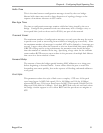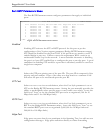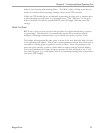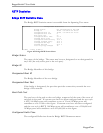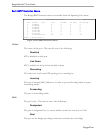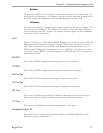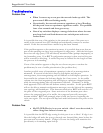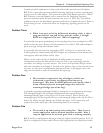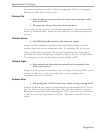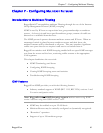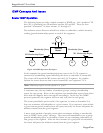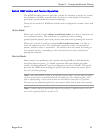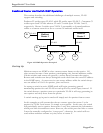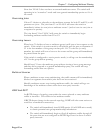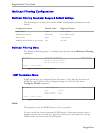
Chapter 6 – Configuring Rapid Spanning Tree
Another possible explanation is that some links in the network run half duplex.
RSTP uses a peer-peer protocol called Proposing-Agreeing to ensure transitioning
in the event of a link failure. This protocol requires full duplex operation. When
RSTP detects a non-half duplex port it cannot use the Proposing-Agreeing
protocol and must make the port transition the slow (i.e. STP) way. If possible
configure the port for full duplex operation otherwise configure the port’s Point to
Point setting to true. Either will allow the Proposing-Agreeing protocol to be
used.
Problem Three
• When I test your switch by deliberately breaking a link, it takes a
long time before I can poll devices past the switch. I thought
RSTP was supposed to be fast. What is happening?
Is it possible that ports participating in the topology have been configured to STP
mode or that the port’s Point to Point parameter is set false? STP and multipoint
ports converge slowly after failures occur.
Is it possible that the port has migrated to STP? If the port is connected to the
LAN segment by shared media and STP bridges are connected to that media then
convergence after link failure will be slow.
Delays on the order of tens or hundreds of milliseconds can result in
circumstances where the link broken is the sole link to the root bridge and the
secondary root bridge is poorly chosen. The worst of all possible designs occurs
when the secondary root bridge is located at the farthest edge of the network from
the root. In this case a configuration message will have to propagate out to the
edge and then back in order to reestablish the topology.
Problem Four
• My network is composed of ring of bridges of which two
(connected to each other) are managed and the rest of
unmanaged. Why does the RSTP protocol work quickly when I
break a link between the managed bridges but not in the
unmanaged bridge part of the ring?
A properly operating unmanaged bridge is transparent to configuration messages.
The managed bridges will exchange configuration messages through the
unmanaged bridge part of the ring as if it is non-existent. When a link in the
unmanaged part of the ring fails however, the managed bridges will only be able to
detect the failure through timing out of hello messages. Full connectivity will
require three hello times plus two forwarding times to be restored.
Problem Five
• The switch is up and running and working fine. Then I start a
certain application and the network becomes unstable. After I
stop the application the network goes back to running normally.
RSTP sends its configuration messages using the highest possible priority level. If
QOS is configured to allow traffic flows at the high priority level and these traffic
RuggedCom
59



